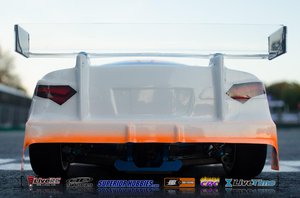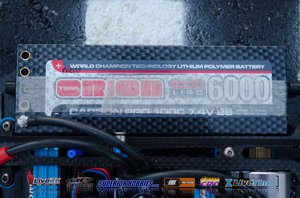The 2012 ISTC World Championship in Heemstede, Netherlands was a homecoming of sorts for Jilles Groskamp, who started his RC racing career at the very same facility twenty years prior. The Dutchman qualified third after setting the fastest time in the fourth round, which gave him a solid opportunity to race for the win. After just one minute into the first A-Main second qualifier Ronald Völker spun off the track after a failed pass attempt on Top Qualifier Atsushi Hara, causing Groskamp to check up - which let Viktor Wilck by for second. Wilck spun out all by himself in a hairpin corner just past the halfway mark, leaving Groskamp to chase down Hara for the win. The two swapped positions several times throughout the final minute of racing, before Groskamp passed Hara on the inside with just a few corners to go for the win. Viktor Wilck finished third.
After a rough start to A2, Groskamp pulled off after just nine laps in order to save his tires. At the 2012 race the drivers were limited to the number of sets of handout tires they were allowed to have, which set up an unfortunate chess game of tire strategy. Hara led for the first portion of the race before Völker stormed by him and took off for the win. Naoto Matsukura finished second and Wilck was third once again.
Five drivers were still mathematically in contention for the win heading into A3, but after Völker’s failed pass attempt on Hara in the chicane on lap five knocked him out of contention the race for the title came down to two - Hara and Groskamp. Jilles knew that, if the race finished in that order, the tiebreaker would come down to the single fastest main event time…and by paying close attention to the announcer’s indication that their pace was over two seconds slower than his winning time from A1, he needed only to cross the line behind Hara to earn the IFMAR World Championship he had desperately chased for so long.
Armed with a brand new car for the 2014 Worlds in Florida, he’s trying to do it again.
Defending IFMAR ISTC World Champion Jilles Groskamp
Chassis: Tamiya TRF419
Motor: Team Orion 4.5-turn Lightweight
Battery: Team Orion Carbon Pro 6000mAh
ESC: Team Orion R10.1
Radio: Sanwa Exzes Z
Servo: Sanwa SRG-BLS
Body: PROTOform LTC-R
Notes: Jilles’ car is fitted with the new shock bodies, which are the same diameter on the outside but the bore has been increased from 10mm to 10.5mm - yet the pistons have remained the same size. He wasn’t sure if these pistons would remain for the production kit. The suspension assemblies are borrowed straight from the TRF418, but the chassis and upper deck will be different on the 419 and may not reflect exactly what’s on Jilles’ car by the time they make it to production. The rear gear differential is larger to hold more oil, and has a new internal ratio.
Jilles pointed out that the best indication of how much wider the bulkheads are - about 1mm on each side - is by looking at how the screws that mount them to the chassis are now aligned with the suspension mount fasteners. The wider bulkheads make the car more stable and have more traction at both ends. Jilles mentioned that the pulleys are larger than those on the 418, which makes the car accelerate more smoothly and feels like it has more traction, and both will be black as the plastic doesn’t show dirt as much as the white plastic on the prototype pulley seen here.

The TRF419’s longer U-shaped motor mount also stiffens the chassis, which Jilles said makes the car more stable when accelerating. The chassis on Jilles’ car is a prototype, featuring screw mount holes that can be used to fasten various accessories from either the TRF418 or TRF419 during testing, and has several holes that won’t be seen on the production version - such as the two between the motor mount’s front holes. Just behind the spur gear cutout (on the left side of this photo) you can see three different mounting holes for the motor mount, as anywhere from 1-3 screws can be used to change the chassis’ stiffness. The overall shape of the chassis may change for the production version as well.
The suspension mounts are now keyed to the chassis to prevent them from tweaking during an accident.

 2024 Philippine Masters Podiums and Sunday RecapApril 23, 2024
2024 Philippine Masters Podiums and Sunday RecapApril 23, 2024 2024 ROAR 1/10th Dirt Off-Road Nationals: Results and PodiumsApril 22, 2024
2024 ROAR 1/10th Dirt Off-Road Nationals: Results and PodiumsApril 22, 2024 Industry Analytics: Weekly Stats [4/10 - 4/17]April 17, 2024
Industry Analytics: Weekly Stats [4/10 - 4/17]April 17, 2024 Orlowski and Lauter Crowned 2024 European 1/12th Scale ChampionsApril 15, 2024
Orlowski and Lauter Crowned 2024 European 1/12th Scale ChampionsApril 15, 2024 Eng / Usd
Eng / Usd Français
Français Deutsch
Deutsch Italiano
Italiano 10/10/2014
10/10/2014
















Recent comments